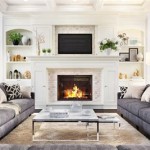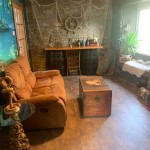How To Warm Up A House Decor
Creating a warm and inviting atmosphere within a home is a multifaceted endeavor involving careful consideration of color palettes, lighting schemes, textural elements, and spatial arrangements. A house that feels cold or sterile may lack a sense of comfort and personality, impacting the well-being of its occupants. This article explores various strategies to effectively warm up a house decor, focusing on key elements that contribute to a cozy and welcoming ambiance.
Utilizing Warm Color Palettes and Strategic Accents
Color heavily influences the perceived temperature of a room. Opting for warm color palettes, such as reds, oranges, yellows, and browns, can significantly contribute to a feeling of warmth. These colors evoke feelings of energy, comfort, and intimacy. However, applying these colors effectively requires careful planning to avoid overwhelming the space.
Consider using warm colors as the dominant hue in rooms that are naturally cooler or receive less sunlight. For example, a north-facing room might benefit from warm-toned paint on the walls. Alternatively, warm colors can be introduced through accent pieces such as throw pillows, blankets, artwork, rugs, and decorative accessories. Incorporating these elements allows for flexibility and can be easily adjusted to suit seasonal changes or personal preferences.
The application of warm colors doesn't necessarily dictate a complete overhaul of the existing decor. Neutral colors can be skillfully incorporated to provide balance and prevent a space from feeling excessively intense. Beige, cream, and light gray provide a subtle backdrop that allows warm-colored accents to stand out. Consider using complementary colors to create visual interest. For instance, pairing a warm red with a cool green can create a dynamic and balanced color scheme.
The choice of material also impacts color perception. Natural materials like wood, leather, and wool tend to have inherent warmth due to their texture and color variations. Incorporating these materials in furniture, flooring, and decor can naturally contribute to a warmer aesthetic. The specific shade of wood, for example, can significantly impact the overall temperature. Darker woods, such as mahogany and walnut, evoke a sense of richness and formality, while lighter woods, such as pine and birch, create a more casual and airy feel.
Color temperature extends beyond paint and furniture. Light bulbs also emit a specific color temperature, measured in Kelvin (K). Lower Kelvin values (2700K-3000K) produce a warm, yellowish light, which is ideal for creating a cozy and inviting atmosphere. Higher Kelvin values produce a cooler, bluish light, which is better suited for tasks requiring focus and concentration. Employing warm-toned light bulbs in living rooms, bedrooms, and dining areas can dramatically impact the perceived warmth of the space.
Layering Textures and Soft Furnishings
Texture is a critical element in creating a warm and inviting atmosphere. A room with a consistent, flat texture can feel sterile and uninviting. Incorporating a variety of textures adds depth, visual interest, and tactile appeal. Layering different textures can transform a space from cold and impersonal to warm and welcoming.
Soft furnishings, such as throw blankets, pillows, rugs, and curtains, are essential for adding texture and warmth. Choose fabrics that are soft to the touch, such as velvet, wool, cashmere, or faux fur. These materials evoke feelings of comfort and luxury. Layering throw blankets over sofas and chairs encourages relaxation and creates a sense of invitation.
Rugs are particularly effective at adding warmth to a room, especially in spaces with hard flooring such as tile or hardwood. Opt for rugs with a thick pile or intricate patterns to add visual interest and tactile warmth. Natural fiber rugs, such as wool or jute, provide a natural and earthy texture that complements a variety of decor styles. The size of the rug is also important. A rug that is too small can look out of place, while a rug that is too large can overwhelm the space. Ideally, a rug should be large enough to define the seating area and anchor the furniture.
Curtains play a crucial role in insulating a room and controlling the amount of natural light entering the space. Heavy, lined curtains provide excellent insulation and can help to block out drafts. Choose fabrics with a rich texture, such as velvet or brocade, to add a touch of luxury and warmth. Lighter fabrics, such as linen or cotton, can create a more casual and airy feel. Layering different types of curtains, such as sheer curtains under heavier drapes, allows for greater control over light and privacy.
Beyond soft furnishings, consider incorporating natural textures such as wood, stone, and plants. Wooden furniture, such as coffee tables and bookshelves, adds a warm and rustic element to a room. Stone fireplaces provide a focal point and add a sense of history and character. Plants introduce life and vibrancy, while also purifying the air. Consider incorporating a variety of plants with different textures and colors to add visual interest.
Even subtle details, such as textured wallpaper or wall hangings, can contribute to the overall warmth of a space. Textured wallpaper can add depth and visual interest to a room without requiring a complete paint job. Wall hangings, such as tapestries or woven art, add a personal touch and can help to soften the lines of a room. The key is to create a sense of depth and complexity through the strategic use of texture.
Optimizing Lighting and Ambiance
Lighting is a powerful tool for transforming the ambiance of a room. A well-lit room feels inviting and comfortable, while a poorly lit room can feel cold and unwelcoming. Optimizing the lighting scheme is essential for creating a warm and welcoming atmosphere. This includes considering the type of lighting, the placement of fixtures, and the overall brightness of the space.
Layering different types of lighting is crucial for creating a balanced and versatile lighting scheme. This includes ambient lighting, task lighting, and accent lighting. Ambient lighting provides overall illumination for the room, while task lighting is focused on specific activities, such as reading or cooking. Accent lighting highlights specific features, such as artwork or architectural details.
Ambient lighting can be provided by a variety of fixtures, such as chandeliers, pendant lights, and recessed lighting. Choose fixtures that emit a warm, diffused light to create a cozy atmosphere. Dimmer switches allow for adjusting the brightness of the light to suit different activities and moods. Task lighting is essential for areas where specific tasks are performed. Desk lamps, floor lamps, and under-cabinet lighting provide focused illumination for reading, writing, and cooking. Accent lighting can be used to highlight artwork, plants, or architectural details. Spotlights, picture lights, and track lighting are effective for highlighting specific features.
The placement of lighting fixtures is also important. Place lamps strategically to create pools of light in different areas of the room. Avoid placing light fixtures directly overhead, as this can create harsh shadows and a clinical feel. Instead, position lamps at different heights to create a more layered and dynamic lighting scheme. Consider using wall sconces to add a touch of elegance and warmth. Wall sconces provide indirect lighting that is both flattering and functional.
Candles and fireplaces are classic ways to add warmth and ambiance to a room. The flickering flame of a candle creates a sense of intimacy and romance. Place candles on mantels, tables, and shelves to add a touch of warmth and sparkle. Fireplaces provide both physical warmth and visual appeal. A roaring fire can transform a room into a cozy and inviting haven. If a real fireplace is not feasible, consider using an electric fireplace or a faux fireplace with candles to create a similar effect.
Natural light is also an important factor to consider. Maximize the amount of natural light entering the room by keeping windows clean and uncluttered. Use sheer curtains or blinds to allow sunlight to filter through while maintaining privacy. Mirrors can be used to reflect natural light and brighten up a room. Place mirrors strategically to capture sunlight and bounce it around the space.
The choice of light bulbs also impacts the overall ambiance of the room. As mentioned earlier, warm-toned light bulbs (2700K-3000K) create a cozy and inviting atmosphere. Avoid using cool-toned light bulbs (4000K-5000K) in areas where you want to create a warm and relaxing ambiance. Experiment with different types of light bulbs to find the perfect balance of brightness and color temperature for each room.

6 Ways To Warm Up The Living Room Without Turning Heat

How To Warm Up A Modern Space Mansion Global

6 Ways To Warm Up Your Home Decor This Winter

How To Warm Up A Room Décor Eoy The Wood

8 Ways To Warm Up A White Room The Sommer Home

8 Ways To Warm Up Your Interiors This Winter Artiss

6 Ways To Warm Up The Living Room Without Turning Heat

Neutral Colors And Grey Interior Design Warming Up Tips

White Decor Ideas How To Warm Up A Monochromatic Space Architectural Digest

Easy Ways To Warm Up Your Home Interior Design Tips Tricks House Of Valentina
Related Posts







